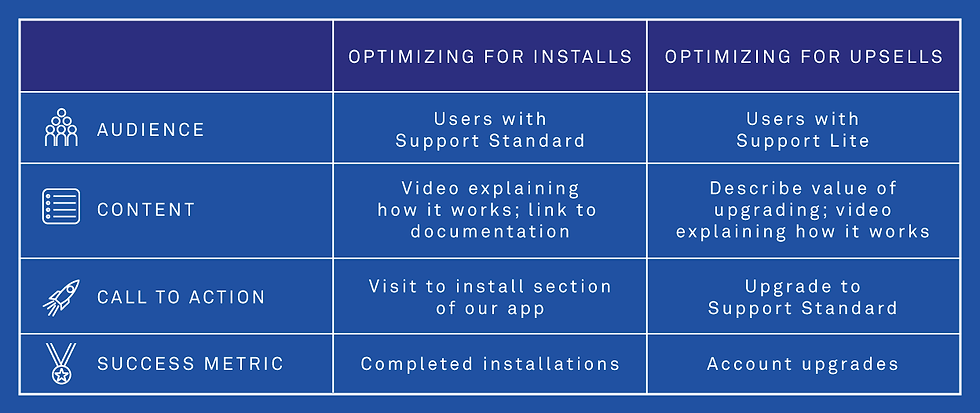The power of data-informed marketing
- Fahad H

- Apr 6, 2016
- 4 min read
Marketers know instinctively their work impacts the bottom line (traffic spikes, growing signups), but they don’t always know which work is making the most impact.
Before joining Intercom I worked in startup finance – think operating plans, fundraising, SaaS metrics, board reporting. I constantly asked the marketing team to prove their work was leading to profit. It’s not that I didn’t think they were adding value, but someone had to report to the board. Now, as a product marketing manager, the tables have turned. I’m still in the demanding world of startups, where every minute and dollar counts, but I’m forced to face my own questions.
No matter how good a product is, a company needs to cut through the noise to reach the masses and convince them to become customers. The work I do now, much of it creative, isn’t so easy to measure as counting pull requests, deals won, or days to month-end close – but it’s just as important. So, to make the best use of time and money (old habits really do die hard), before I go into any task or project, I ask: what will the impact be? And more importantly: how will I prove it?

Nuance matters. Correctly defining your desired outcome will clarify how you design and execute your project.
For a landing page, is your goal to help people understand the product offering or to get them to sign up? If the former, you might be tempted to “feature dump” and tell them every single little thing the product is capable of. However, if you optimize for signups, you will design your landing page to quickly communicate the problem the product solves and offer a clear call to action.
For a feature announcement, is your goal to get views, likes, or installs? Of course, lots of views would be nice, but that doesn’t mean you should spam your entire contact list. Likes are nice too, but catchy copy and pretty pictures don’t necessarily convert. Rather, your goal should be to optimize for feature adoption, and every element of your campaign should be created through that lens. Be sure your announcement is targeted to users who can actually use what you are announcing.
Say I’m introducing a new integration available on Support Standard:


We’ve all heard “what gets measured, gets improved”. If you don’t find a way to quantitatively measure your work, you will keep spinning your tires.
These are tactics we employ at Intercom:
Attach a UTM code to a custom URL to track the source, medium, and campaign name. With the UTM codes on this link to our popular microsite, Product Strategy Means Saying No, we can analyze how much traffic to that page originates from this blog post.
Set a goal to measure how effective your message is. For example, when we announced our new Facebook integration, we expected a lot of views and likes simply because of Facebook’s brand recognition. But because we attached the goal “installed Facebook integration”, we were able to see it had incredibly high conversion rates. This surprising insight lead us to prioritize adding new inbound messaging channels in the future.
Don’t just track sign ups – track which page and where on the page they sign up. This additional context says quite a bit. Are they converting in the first call to action? That might mean your landing page needs less content, simpler copy, or should be optimized to be fast rather than flashy.

Analytics isn’t usually in marketing’s wheelhouse, so it is often not prioritized. Don’t make the mistake of thinking that once your product is launched, you are done (pro tip: you aren’t). It takes investment, skills, and help from other teams to have the right infrastructure to measure and optimize your work.
Here are four ways our marketing team measures performance:
A/B test your messages and landing pages. If pages with a video perform better than pages without, you’d know to invest more time and money on videos.
Build Looker dashboards to track traffic, conversions, and revenue. Knowing product pages that show up first get the most traffic might make you re-order to match the buyer’s journey (simple, sticky products first, followed by the more powerful and complex).
See heat maps of interactions with your pages using Inspectlet. Losing people to scroll fatigue? Move the CTA up higher and see if it improves conversions.
Conduct simple, yet impactful user studies. A good time to do research is after you’ve made some big changes. The best time to do it is before.
Many of these tools and tactics can be executed with limited budgets and technical skills. As your traffic grows, even small improvements to conversions can go a long way to maximizing your top of funnel efforts.

Marketing is one of the broadest fields in business. It can span from creative tasks such as graphic design and writing to technical objectives like paid advertising and search engine optimization. It affects every person that interacts with your brand and nearly every group in your organization, so it’s no stretch to say effective marketers have a huge impact – positive or negative – on a startup’s growth and profitability.
To optimize what’s working and replace what isn’t, approach marketing with an ROI-driven mindset, and you’ll get the most of your team’s creative powers.








Comments